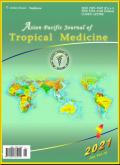Impact of H1N1, H7N9, ASFV, dengue virus and COVID-19 on pharmaceutical manufacturing firms' R&D investments and economic consequences: Evidence from China
IF 1.6
4区 医学
Q3 PUBLIC, ENVIRONMENTAL & OCCUPATIONAL HEALTH
引用次数: 0
Abstract
Objective: To determine the impact of major disease epidemics on pharmaceutical manufacturing firms' Research & Development (R&D) investments and economic consequences. Methods: The sample consists of 1 582 firm-year observations from 2009 to 2022 in China, of which, 26.6% of pharmaceutical companies are involved in the diagnosis and treatment of prevalent diseases. Linear models using R&D investments, patent applications, operating performances and stock returns as dependent variables are constructed separately to examine the response of pharmaceutical companies to disease epidemics and the resulting economic consequences. Results: The prevalence of five major diseases led to a 17.5% increase in the amount of R&D investment and an 87.8% rise in the ratio of R&D investment to total assets by disease-related pharmaceutical companies, compared to unrelated pharmaceutical companies. Further evidence indicated that the patent applications for disease-related firms increased by 44.3% relative to unrelated firms after the epidemics. Though the impacts of the epidemics on firms' operating performances were insignificant in the short term, a major disease epidemic was associated with an increase in stock returns of 67.4% and 44.6%, respectively, as measured by the capital asset pricing model and Fama-French five-factor model. Additional analysis revealed that the impacts of the epidemics on R&D investments and patent applications were more pronounced for non-state-owned enterprises than state-owned enterprises. Conclusions: This study demonstrates that disease-related pharmaceutical firms respond to the disease epidemics through increasing R&D investment. More patent applications and higher market value are the main gains from the firms' increased investments in R&D following the epidemic, rather than the improvements of short-term operating performances.H1N1、H7N9、ASFV、登革热病毒和COVID-19对制药企业研发投资和经济后果的影响:来自中国的证据
目的:了解重大疾病流行对制药企业科研活动的影响;开发(研发)投资和经济后果。方法:样本由2009 - 2022年中国1 582个公司年观察数据组成,其中26.6%的制药公司参与了流行疾病的诊断和治疗。使用研发投资、专利申请、经营业绩和股票回报作为因变量的线性模型被单独构建,以检验制药公司对疾病流行的反应和由此产生的经济后果。结果:五大疾病的流行导致疾病相关制药公司研发投入比非疾病相关制药公司增加17.5%,研发投入占总资产的比例比非疾病相关制药公司增加87.8%。进一步的证据表明,疫情过后,与疾病相关的企业的专利申请比不相关的企业增加了44.3%。虽然流行病对企业经营绩效的影响在短期内不显著,但通过资本资产定价模型和Fama-French五因素模型测量,重大疾病流行与股票收益的增长分别为67.4%和44.6%。进一步的分析显示,疫情对研发投资和专利申请的影响对非国有企业比对国有企业更为明显。结论:研究表明疾病相关制药企业通过增加研发投入来应对疾病流行。更多的专利申请和更高的市场价值是企业在疫情后增加研发投资的主要收益,而不是短期经营业绩的改善。
本文章由计算机程序翻译,如有差异,请以英文原文为准。
求助全文
约1分钟内获得全文
求助全文
来源期刊

Asian Pacific journal of tropical medicine
PUBLIC, ENVIRONMENTAL & OCCUPATIONAL HEALTH-TROPICAL MEDICINE
CiteScore
4.00
自引率
9.70%
发文量
1936
审稿时长
3-8 weeks
期刊介绍:
Asian Pacific Journal of Tropical Medicine (ISSN 1995-7645 CODEN: APJTB6), a publication of Editorial office of Hainan Medical University,is a peer-reviewed print + online Monthly journal. The journal''s full text is available online at http://www.apjtm.org/. The journal allows free access (Open Access) to its contents and permits authors to self-archive final accepted version of the articles on any OAI-compliant institutional / subject-based repository.
APJTM aims to provide an academic communicating platform for international physicians, medical scientists, allied health scientists and public health workers, especially those of the Asia-Pacific region and worldwide on tropical medicine, infectious diseases and public health, and to meet the growing challenges of understanding, preventing and controlling the dramatic global emergence and re-emergence of infectious diseases in the Asia-Pacific.
The journal is proud to have an international and diverse editorial board that will assist and facilitate the publication of articles that reflect a global view on tropical medicine, infectious diseases and public health, as well as emphasizing our focus on supporting the needs of public health practitioners. The APJTM will allow us to seek opportunities to work with others who share our aim, and to enhance our work through partnership, and to uphold the standards of our profession and contribute to its advancement.
 求助内容:
求助内容: 应助结果提醒方式:
应助结果提醒方式:


